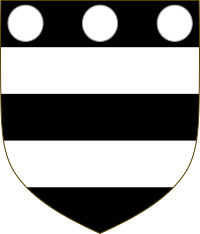Robert Hungerford, 3rd Baron Hungerford facts for kids
Quick facts for kids
Robert Hungerford
|
|
|---|---|

Arms of Hungerford: Sable, two bars argent in chief three plates
|
|
| Born | c. 1429 England |
| Died | 17 May 1464 (aged c. 35) Newcastle, Northumberland |
| Resting place | Salisbury Cathedral |
| Title | Baron Hungerford |
| Tenure | 1459–1469 |
| Other titles | Baron Moleyns |
| Wars and battles | Wars of the Roses Battle of Towton (1461) Battle of Hexham (1464) |
| Spouse(s) | Eleanor Moleyns |
| Issue | Thomas of Rowden Walter of Farleigh |
| Parents | Robert, 2nd Baron Hungerford Margaret Botreaux |
|
|
|
Robert Hungerford, 3rd Baron Hungerford (born around 1429 – died 17 May 1464) was an important English noble. He lived during a time of great conflict in England. Robert Hungerford supported the Lancastrian side in the Wars of the Roses. This was a series of battles fought between two powerful families, the Lancastrians and the Yorkists, who both wanted to rule England.
Robert Hungerford was a member of the English Parliament in the late 1440s and early 1450s. He was held prisoner by the French for many years. His mother had to pay a very large sum of money to get him back. In 1461, after a big battle, he had to run away to Scotland with King Henry VI. He was later captured and executed in Newcastle.
Contents
Who Was Robert Hungerford?
Robert Hungerford was the son of Robert Hungerford, 2nd Baron Hungerford. His grandfather was Walter Hungerford, 1st Baron Hungerford. His mother was Margaret, who was the 4th Baroness Botreaux.
Robert Hungerford's Life and Work
Robert Hungerford became a Baron after he married Eleanor de Moleyns. She was an heiress, meaning she would inherit a lot of land and money. Because of this marriage, he was called to join Parliament as Baron Moleyns in 1445. He continued to be part of Parliament until 1453.
What Happened with John Paston?
In 1448, Robert Hungerford had a big argument with a man named John Paston. They disagreed about who owned a piece of land called Gresham Manor. Hungerford took over the land by force. A bishop tried to help them settle the argument, but it didn't work.
Paston got the land back, but in 1450, Hungerford sent many men to take it again. They even threatened Paston's wife, Margaret. In the end, Hungerford had to give the manor back to Paston.
Being a Prisoner in France
In 1452, Robert Hungerford went with another noble, John Talbot, 2nd Earl of Shrewsbury, to a place called Aquitaine in France. He was captured during a battle. His ransom, which is money paid to free a prisoner, was very high. It was about 7,966 pounds. To get him back, his mother sold her valuable items and borrowed money using her lands.
He was finally released in 1459, after being a prisoner for more than seven years. Because of his difficult time, he was given special permission to sell a lot of wool without paying taxes. He also got permission to travel, and he visited Florence in Italy.
Fighting in the Wars of the Roses
By 1460, Robert Hungerford was back in England. He played a big part on the Lancastrian side in the Wars of the Roses. In June 1460, he and his friends went to the Tower of London for safety. This was when the Yorkist leader, the Earl of Warwick, entered the city.
After the Lancastrians lost the Battle of Northampton in July 1460, Hungerford and his friends gave up the Tower. They were allowed to leave freely.
Robert Hungerford also fought in the Battle of Towton in March 1461. The Lancastrians lost again. After this defeat, Hungerford ran away with King Henry VI to Scotland. He went to France to try and get help for the King and Queen Margaret. He was briefly held by French officials in August 1461. He wrote to Queen Margaret, telling her not to give up hope.
In November 1461, the new King, Edward IV (who was a Yorkist), declared Hungerford a traitor. This meant Hungerford lost his lands and titles. He tried to gather support for the Lancastrians in northern England. However, he was captured at the Battle of Hexham on 15 May 1464. He was executed in Newcastle soon after.
Family Life
Around 1441, when he was very young, Robert Hungerford married Eleanor de Moleyns. She was born in 1426 and died in 1476. Eleanor was the daughter and heiress of William de Moleyns. Her father was killed during the Siege of Orleans in France.
Eleanor lived longer than Robert. She later married another man named Sir Oliver Manningham. She was buried in a place called Stoke Poges in 1476. Robert and Eleanor had two sons:
- Sir Thomas Hungerford
- Sir Walter Hungerford
Death and What Happened Next
Robert Hungerford was captured at the Battle of Hexham on 15 May 1464. He was taken to Newcastle and executed there on 17 May. He was buried at Salisbury Cathedral.
After his death, many of his lands were given to Richard, Duke of Gloucester, who later became King Richard III. Other parts of his property were given to John Wenlock, 1st Baron Wenlock. King Edward IV told Wenlock to make sure Robert Hungerford's wife and young children were taken care of.

